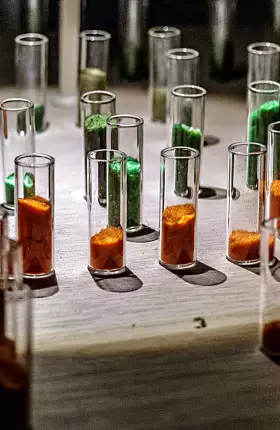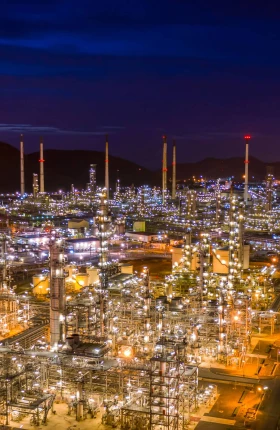A year ago, executives at many of the world’s biggest chemical companies were fretting about growth. Demand had weakened, and they were concerned that the decade might get off to a bumpy start.
No one, however, expected 2020 to be like this.
The coronavirus pandemic has delivered a tremendous blow to the industry and initially (in March) sent chemical shares down 35%. Chemical stocks have subsequently rebounded along with the broader market. But the financial and operational impact of COVID-19 on this industry is real and isn’t going away anytime soon.
Extrapolating from estimates by the American Chemistry Council, Boston Consulting Group expects that global chemical revenues will drop 9% this year (owing more to a decrease in prices than volumes) before rebounding by 10% in 2021. That would put 2021’s global chemical revenues very close to 2019’s $4 trillion.
But since nobody knows for sure, it’s crucial for chemical companies to make a clear-eyed assessment of what’s going on now—and determine the adjustments they should make given their value chain and asset footprint, end-industry exposures, and technical, commercial, and digital capabilities.
The financial and operational impact of COVID-19 on the chemical industry is real and isn’t going away anytime soon.
End-Market Sales and Segment Profitability During the Pandemic
Since the pandemic began, we have been tracking its impact on eight key end-use chemical markets. (See Exhibit 1.) In the first six months of this year, chemical companies with a heavy exposure to automotive and aerospace end markets took the most direct hit from a financial perspective. The downside of a chemical company being overexposed to the automotive market isn’t new; it is a continuing challenge that we touched on in last year’s version of this report . But the coronavirus, by triggering an even bigger drop than expected in automotive demand, has caused an unfavorable situation to quickly get worse.
We don’t need to spend a lot of time discussing the risks of aerospace end-market exposure. The enormous contraction in air travel since March is a widely publicized economic issue and well understood. Only a handful of the 246 companies in our overall chemicals sample have an aerospace end-market exposure exceeding 3%. These companies will have no option but to cut costs and reduce their aerospace-related investments.
Another end market that got hit in the early part of the year is personal care, which includes product categories like perfumes and cosmetics. Demand for these items dropped substantially as many social occasions and face-to-face interactions were put on hold.
Electronic products have been mixed since the pandemic began. The auto slowdown and retail store closures have been a drag on electronics demand, as have lower consumer discretionary incomes. But demand has been buoyed by spending on data centers and other areas of commercial infrastructure and by the increasing use of home electronics for both work and entertainment.
And then there are the end-market exposures that are more clearly favorable. The pandemic has focused attention on the importance of hygiene and health care products and given a boost to chemical companies that serve pharmaceutical makers. It has also led to far more at-home food preparation, benefiting chemical companies that are part of the global food supply chain.
In addition to reviewing the pandemic’s impact on end markets, we looked at how it is affecting the profitability of some important product segments. We would bet that at some point in March, most chemical executives realized they were likely to see a significant erosion in their companies’ bottom lines. And that is exactly what has happened. Of 20 chemical product segments that we analyzed, only two had higher profits in the first half of the year. (See Exhibit 2.)
One of the hardest hit segments was petrochemicals and polymers, which has struggled with falling prices this year. Profits in this segment tumbled sharply, despite the increased use of disposable plastics as a safety measure during the pandemic. The rise in the use of disposable plastic is proving to be temporary anyway. (See “Single-Use Plastic in the Year of the Pandemic.”)
Single-Use Plastic in the Year of the Pandemic
After the coronavirus hit, however, the pressure abated, as people became concerned about the possibility of contracting a deadly virus from infected surfaces. If a piece of plastic can protect us from chance transmission, why not use it?
This thinking prompted officials in California, New York City, and the UK to postpone the implementation of single-use plastic bans. In India, the amount of single-use plastic had again accumulated to such an extent in mid-2020 that doubt arose about the feasibility of a plan to eliminate such products by 2022.
But the pressure has returned, with California, New York City, and the UK all resuming their bans.
The push toward responsible plastics use requires contributions from plastics makers, brand owners, and municipalities. Chemical companies have a role to play too, of course, and should continue their investments in more circular plastics ecosystems. This will work to their advantage in a world where recycled plastic is becoming the norm and where those seen as harming oceans and other parts of the environment will increasingly be penalized.
Construction is among the chemical product segments that have held up somewhat better. Public construction projects were generally put on hold when the pandemic began. (Many have now restarted.) But with people stuck at home, a different area of construction—repairs and do-it-yourself projects—thrived. This increased the demand for light building materials (including caulk, sealants, and decorative paint), buoying chemical companies that manufacture ingredients for such products and keeping these companies from taking the profit hit that other economically sensitive end markets were experiencing.
Longer-Term Chemical Industry TSR Remains Stable
This “COVID moment” follows a five-year period during which total shareholder returns (TSRs), in the chemical industry as a whole, did not change much. From 2015 to 2019, the TSR of the average chemical company rose by 8%—identical to the average in the previous five-year period. (Boston Consulting Group looks at TSRs on a rolling five-year basis to spot trends and see how companies are performing over the longer term. See “How We Calculate and Report TSR.”)
HOW WE CALCULATE AND REPORT TSR
All those factors interact—sometimes in unexpected ways. A company may increase its earnings per share through an acquisition but create no TSR if the acquisition erodes its gross margins. In addition, some forms of cash contribution (like dividends) can impact a company’s valuation multiple in different ways than others (like a share buyback); the effects are complex.
In this report, the TSRs used for groups and comparative purposes are generally medians. The TSRs associated with individual companies are straight calculations of those companies’ capital gains and cash flows, rounded to the nearest percentage.
The 8% average five-year TSR among chemical companies was 1.6 percentage points lower than the average of all industries. As a point of comparison, financial institutions (a sector that includes Mastercard) and technology companies (a sector that includes Apple) were near the top of BCG’s TSR rankings in the latest five-year period . Companies in those sectors had median TSRs of 20% and 18%, respectively. Automotive OEMs were dead last with a five-year TSR of zero.
Within the chemical industry’s 8% average TSR, there were considerable differences, both by region and by subsector. Geographically, the most notable development is Europe’s rise. In the most recent five-year period, European chemical companies had the best TSRs, with a regional average of 11%. (See Exhibit 3.) It wasn’t so long ago that Europe’s five-year TSRs were the worst of any geographic area we cover.
Europe’s strong relative performance stands in stark contrast to that of chemical companies in North America, which had the lowest TSRs of any region. The focused specialty and base chemical and basic plastics subsectors were the biggest areas of difference. European base chemical companies have gone through restructurings to reduce their production capacities and make their assets more efficient. In North America, base chemical companies have seen their previous cost advantage from shale gas decline. Low oil prices have caught many North American base chemical companies unprepared, diminishing their profitability and causing them to pull back on their investments. US base chemical companies have also been hurt by the trade war with China, which reduced US companies’ competitiveness in China in 2019. Given these factors, a second consecutive period of negative TSRs for North American base chemical companies (their TSRs were negative from 2014 to 2018, too) isn’t a surprise.
Also helping European chemical TSRs, and hurting those in North America, was a difference in growth rates. European chemical companies, on average, had top-line increases of 4% annually in the most recent five-year period. Among the fastest growers were the focused-specialty companies Hexpol and Synthomer, both with annual jumps of 11%.
Europe was the only one of the five regions we cover where top-line growth in the most recent five-year period matched that in the previous five-year period. In every other region—emerging markets, Northeast Asia, Greater China, and North America—revenue growth has fallen. The median North American chemical company had no top-line growth at all during the most recent five-year period. Among those bucking the trend in North America were International Flavors & Fragrances and Sherwin-Williams, which both had annual growth rates of 10%.
Focused Specialties’ Flat EBITDA Multiples. For a big part of the past decade, there was a sizable difference between the TSRs of focused-specialty companies and multispecialty companies: focused-specialty companies performed much better. That differential was still in place in Europe during the most recent period and—to a lesser extent—in North America. Overall, however, the differential has essentially disappeared. (See Exhibit 4.)
We do not think the narrowing gap negates the fundamental advantage of focused-specialty companies , including their agility, their ability to make more concentrated R&D investments, and the expertise they have in specific application areas. Instead, the smaller difference is explained by a sharp decline in focused specialties’ EBITDA multiples—their financial outperformance is now factored into their stock prices. (The EBITDA multiple, which reflects future expectations, is one of four drivers of TSR.)
Additional Factors Affecting Chemical TSRs. In the latest five-year period, large chemical companies did considerably better than mid-cap chemical companies from a TSR perspective. (We consider those with market capitalizations above $7 billion to be large and those with market capitalizations between $1 billion and $7 billion to be midsize.) Large chemical companies are almost exactly in the middle of all industries in TSR, and mid-caps are in the bottom quintile.
Among the large companies in our sample, several have done an extraordinarily good job of long-term TSR development (not just over the past five years but over the past ten). One is the Swiss company Sika (five-year TSR of 32%; ten-year TSR of 23%), which has become a worldwide leader in construction chemicals through an effective M&A strategy. Another Swiss chemical company, Lonza, has done a good job of positioning itself in the fast-growing market for pharmaceutical ingredients. It has a five-year TSR of 29% and a ten-year TSR of 21%. (See Exhibit 5 for our ranking of the leading large-cap companies by five- and ten-year TSRs.)
The list of those that have outperformed over a sustained period also includes three Indian companies: Berger Paints, Pidilite, and Asian Paints (with five-year TSRs of 30%, 21%, and 20%, and ten-year TSRs of 39%, 31%, and 27%, respectively). These companies have all benefited from India’s remarkable economic rise. Of course, it remains to be seen how these companies will fare in the immediate future, given the devastating impact that COVID-19 is having on India. All three companies saw their sales drop by more than 40% in this year’s second quarter.
From a TSR perspective, the pandemic seems to be mostly accelerating long-term trends, not reversing them. That is clear from the product segments that have held up the best since the pandemic was declared. Chemical companies like Lonza that contribute to the pharmaceutical and health care value chains had the highest TSRs in the first half of this year. Food ingredient and electronic chemical companies, hard hit in the first quarter, rebounded strongly and were showing positive TSRs as of the middle of 2020. (See Exhibit 6.)
In their own ways, the companies operating in these product segments all have high levels of resilience. That could mean not being as asset intensive as other chemical companies, being less dependent on commodity cycles, or being more insulated from macroeconomic swings. Their resilience makes them appealing to shareholders.
By contrast, companies focused on commodity product segments—including vinyl chloride, synthetic rubber, and fertilizers—had double-digit TSR losses in the first half of this year. These product segments already had low TSRs before COVID-19 came along; they have since fallen into negative territory.
A New Challenge Born of Declining Returns
Over and above the many issues that the industry is now facing, there is also concern about one financial metric that has been falling: return on capital employed (ROCE). The drop in ROCEs isn’t new; it began about a decade ago. (See Exhibit 7.) But the ROCE decline has been accelerating, and coupled with the lower cash flows from the economic slowdown, it is starting to have a real impact, both on valuations and on the scrutiny that capital projects receive.
ROCEs can’t be fixed overnight; chemical companies’ past investments make that impossible. But companies can make a number of moves to get on the road to stronger ROCEs. The first set of moves involves margin improvement—which could be accomplished through increased asset utilization, a better product mix, or a reduction in conversion costs. Many chemical companies already use these levers.
The second set of moves—which are less common—involve asset productivity. Higher asset productivity can be achieved by managing the capital allocation model so that only the highest-return businesses, products, and geographic areas receive capital. A skewing of the allocation model would also mean heavy scrutiny of new capital projects, the adoption of asset-light business models, and the divestiture of underperforming assets that aren’t good fits.
A combination of key moves will put chemical companies on a path to better ROCEs and could give the industry a TSR boost.
A combination of these moves will put chemical companies on a path to better ROCEs and could give the industry a TSR boost.
Navigating in an Uncertain Era
Before they look too far down the road, however, chemical companies must find a way to thrive despite the current uncertainty. Here are the four actions that we think are most important.
Increasing Resilience. Chemical companies were caught off-guard by how quickly demand evaporated amid the pandemic. Almost half the companies in our universe had double-digit sales declines during the first half of this year, and a fifth saw their sales plunge by 20% or more.
The speed of the downturn reminded companies of how useful it is to have a cost structure that can rapidly be scaled back in the event of a major drop in demand. One way companies can do this is by variabilizing a greater portion of their costs, which could include rethinking where they usually come down on make-versus-buy decisions. Moving to managed services is another way to variabilize costs—it’s much easier to decrease spending on noncore roles or functions when third parties are providing them.
The idea of resilience—of being able to withstand external shocks—is getting new attention at chemical companies.
Improved resilience can also take the form of a move to localize supply chains. The goal can be risk reduction—mitigating the impact of trade disruptions caused by tariffs, port congestion, or natural disasters. Or the goal can be to get closer to customers physically and provide better service. Some chemical companies were already starting to localize their supply chains prior to the pandemic. COVID-19 is accelerating this trend.
And of course, companies are protecting their businesses through more standard cost-cutting measures, including workforce reductions, delayed or cancelled decisions on capacity expansion, and rethinking how they do procurement spending.
A Deeper Embrace of Digital Technology. Chemical executives have talked about using digital technology for years, mostly as a way of lowering costs in various parts of their businesses. In the all-important go-to-market area, which includes sales, interfaces to distributors, technical marketing, and self-service platforms, digital has played little to no role in the chemical sector. The conventional wisdom among chemical executives is that customers are conservative and want their sales representatives to show up in person to discuss business conditions and upcoming products—and to do a bit of glad-handing.
It’s not clear that this was ever so important, but the whole idea of in-person sales meetings seems outmoded in the era of COVID-19. At this point, many customers would prefer that sales transactions not be conducted face to face. Indeed, video-enabled and online selling have already begun, with positive results.
A bigger challenge than sales, in chemical companies’ bid to become more digital, involves product and application development. Many best-selling SKUs exist only because of direct collaborations between two product development teams—the customer’s and a chemical company’s. It’s not easy to be responsive and achieve customer intimacy when people aren’t working together physically. Formulation adjustments, prototypes, and production samples are all essential parts of the bespoke products that chemical companies develop. While some point solutions are available (involving augmented reality or virtual reality), most companies are not close to having a seamless digital interface to use with customers.
A More Agile, Responsive R&D Function. Suppose one of a company’s products is fibers and one of its end markets is personal protective equipment (PPE). In 2018 or 2019, such a company may well have seen this end market as relatively uninteresting and lacking in growth potential.
With COVID-19, however, the demand for PPE is rising—and changing. More innovation is needed, to create masks that are more comfortable, longer lasting, or more protective and that have a “smart” digital component. As an end-use market, PPE has become more interesting and much more lucrative, extending beyond its previous appearance in industrial plants and health care settings to industries such as hospitality and restaurants. Sanitizer and disinfectants is another area of seemingly simple chemistry that is suddenly full of opportunity. Chemical companies are jockeying to have the best formulations, with the most persistent protective properties, the lowest likelihood of drying out a person’s hands, and the greatest safety.
A big part of the chemical industry’s value lies in innovation—coming up with products that make life simpler, healthier, better. The physical world and its needs are never static, as the pandemic has shown. The best chemical companies will direct their R&D efforts toward these ever-changing needs while filtering out the opportunities that don’t have durable economic value.
An Opportunistic Use of M&A. The global crisis has also provided an occasion to rethink portfolios. Who will be a buyer and who a seller will depend on the strategic priorities of different chemical companies and on the condition of their balance sheets. Some chemical companies are overleveraged and will want to do everything they can, as early as they can, to avert a liquidity crisis. This could create an opportunity for those that have held up the best.
The global crisis has provided an occasion to rethink portfolios.
An example of opportunistic M&A took place over the summer, when Ineos acquired BP’s chemical business. Ineos had approached BP, one of the world’s largest energy producers, well before the coronavirus hit, knowing that chemicals weren’t a core part of BP. But the coronavirus accelerated the energy company’s timetable for a deal, allowing Ineos to pick up assets that fit well with its existing portfolio.
Most big chemical companies regularly reevaluate their business portfolios; many of them maintain an active list of possible acquisitions and divestments. We expect to see more strategic transactions of the Ineos-BP sort, and possibly even some distressed-asset transactions, as the global economy continues to go through fits and starts.
COVID-19’S Lasting Effects
For many of the chemical executives we talk to, the closest point of comparison for 2020 is 2008. If anything, the economic uncertainty facing their companies now is worse than it was during the financial crisis. The 2008 crisis had a big impact in the West, but faster-growing emerging regions were left largely unscathed, so the chemical industry was still chugging along in parts of the world. The pandemic has affected mature and emerging economies equally.
After 2008, Western chemical companies did what they needed to do in order to stabilize their businesses. They cut costs. They innovated. Equilibrium also came in the form of consolidation and (for a few unlucky companies) bankruptcy. Finally, shale gas emerged as an unexpected boon to North American chemical companies, a little rocket fuel to speed their ascent.
This time companies have more work, and different kinds of work, to do. Success will require increased use of digital and enhanced business model innovation. But what is the best way of executing these changes? That is the question that chemical executives should be pondering. Those who deal most deftly with an uncertain present will have the greatest chance of boosting shareholder value in the future.

















